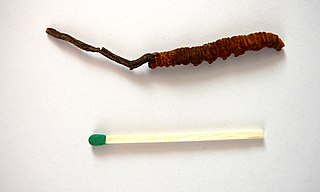
Balitoridae, the hillstream loaches or river loaches, is a family, of small fish from South, Southeast and East Asia. The family includes about 202 species. They are sometimes sold as "lizardfish" or "flossensaugers". Many of the species are popular for aquaria, species in the genus Sewellia are most commonly sold in the aquaria trade. They have a number of similarities with the Cobitidae, their sibling family of "loaches", such as multiple barbels around the mouth. They should not be confused with the loricariids, which look similar but are a family of catfish.

Hibiscus is a genus of flowering plants in the mallow family, Malvaceae. The genus is quite large, comprising several hundred species that are native to warm temperate, subtropical and tropical regions throughout the world. Member species are renowned for their large, showy flowers and those species are commonly known simply as "hibiscus", or less widely known as rose mallow.

Hibiscus × rosa-sinensis, known colloquially as Chinese hibiscus, China rose, Hawaiian hibiscus, rose mallow and shoeblack plant, is a cultigen of tropical hibiscus, a flowering plant in the Hibisceae tribe of the family Malvaceae. It is an artificial hybrid created in cultivation in pre-European times by Polynesians in the west Pacific from the species Hibiscus cooperi and H. kaute. It is widely cultivated as an ornamental plant in the tropics and subtropics.

Ophiocordyceps sinensis, known colloquially as caterpillar fungus, is an entomopathogenic fungus in the family Ophiocordycipitaceae. It is mainly found in the meadows above 3,500 metres (11,500 ft) on the Tibetan Plateau in Tibet and the Himalayan regions of Bhutan, India, and Nepal. It parasitizes larvae of ghost moths and produces a fruiting body which is valued in traditional Chinese medicine as an aphrodisiac. Caterpillar fungus contains the compound cordycepin, an adenosine derivative. However, the fruiting bodies harvested in nature usually contain high amounts of arsenic and other heavy metals, so they are potentially toxic and sales have been strictly regulated by China's State Administration for Market Regulation since 2016.

Clonorchis sinensis, the Chinese liver fluke, is a liver fluke belonging to the class Trematoda, phylum Platyhelminthes. It infects fish-eating mammals, including humans. In humans, it infects the common bile duct and gall bladder, feeding on bile. It was discovered by British physician James McConnell at the Medical College Hospital in Calcutta (Kolkata) in 1874. The first description was given by Thomas Spencer Cobbold, who named it Distoma sinense. The fluke passes its lifecycle in three different hosts, namely freshwater snail as first intermediate hosts, freshwater fish as second intermediate host, and mammals as definitive hosts.

Camellia sinensis is a species of evergreen shrub or small tree in the flowering plant family Theaceae. Its leaves, leaf buds, and stems can be used to produce tea. Common names include tea plant, tea shrub, and tea tree.

Clonorchiasis is an infectious disease caused by the Chinese liver fluke and two related species. Clonorchiasis is a known risk factor for the development of cholangiocarcinoma, a neoplasm of the biliary system.

Angelica sinensis, commonly known as dong quai or female ginseng, is a herb belonging to the family Apiaceae, indigenous to China. A. sinensis grows in cool high altitude mountains in East Asia. The yellowish brown root of the plant is harvested in the fall and used in traditional Chinese medicine. There is no scientific evidence that A. sinensis is effective for any medicinal purpose.

Eosimias is a genus of early primates, first discovered and identified in 1999 from fossils collected in the Shanghuang fissure-fillings of Liyang, the southern city of Jiangsu Province, China. It is a part of the family Eosimiidae, and includes three known species: Eosimias sinensis, Eosimias centennicus, and Eosimias dawsonae. It provides us with a glimpse of a primate skeleton similar to that of the common ancestor of the Haplorhini. The name Eosimias is designed to mean "dawn monkey", from Greek eos "dawn" and Latin simius "monkey".

Sinosaurus is an extinct genus of theropod dinosaur which lived during the Early Jurassic Period. It was a bipedal carnivore similar to Dilophosaurus, with proportionally large limbs to its slender body. Fossils of the animal were found at the Lufeng Formation, in the Yunnan Province of China.

Gyposaurus is a genus of basal sauropodomorph dinosaur from the early Jurassic of South Africa. It is usually considered to represent juveniles of other prosauropods, but "G." sinensis is regarded as a possibly valid species.

The Chinese softshell turtle is a species of softshell turtle that is native to mainland China and Taiwan, with records of escapees—some of which have established introduced populations—in a wide range of other Asian countries, as well as Spain, Brazil and Hawaii.

Miscanthus sinensis, the eulalia or Chinese silver grass, is a species of flowering plant in the grass family Poaceae, native to eastern Asia throughout most of China, Japan, Taiwan and Korea.

The South China catshark is a species of shark belonging to the family Pentanchidae, the deepwater catsharks. This catshark is known only from the holotype, which was taken from the South China Sea at a depth of 537 m (1,762 ft). Its length is 42 cm (17 in), but this measurement was taken from an immature specimen. The reproduction of the South China catshark is oviparous.

The Asian parti-colored bat is a species of parti-coloured bat. An adult Asian parti-colored bat has a body length of 6–7 cm (2.4–2.8 in), a tail of 4.3–4.5 cm (1.7–1.8 in), and a wing length of 5 cm (2.0 in). Asian parti-colored bats are distributed across East Asia, from Taiwan through eastern China, eastern Mongolia and Russia (Siberia) to the Korean Peninsula and Japan.

Citrus × sinensis, a hybrid between pomelo and mandarin, also known as the sweet oranges, is a commonly cultivated species of orange that includes Valencia oranges, blood oranges and navel oranges.
Jinshaia abbreviata is a species of hillstream loach endemic to China. It is one of two species in the genus Jinshaia.

Youngosuchus is an extinct genus of archosaur from the Middle Triassic of China. The type species is Y. sinensis. Y. sinensis was first described in 1973 as a new species of the erythrosuchid Vjushkovia. In 1985, it was reassigned as its own genus of rauisuchid. A 1992 study supported the original classification of Youngosuchus sinensis as an erythrosuchid, but more recent studies classify it as a "rauisuchian"-grade loricatan archosaur completely unrelated to Vjushkovia, which is most likely a synonym of Garjainia.

Jinshaia is a genus of freshwater ray-finned fishes belonging to the family Balitoridae, the loaches in this family are commonly known as hillstream loaches although this name also refers to the loaches in the family Gastromyzontidae. These loaches are endemic to China.

Camellia taliensis is a small species of evergreen shrub whose leaves and leaf buds are used to produce tea.



















